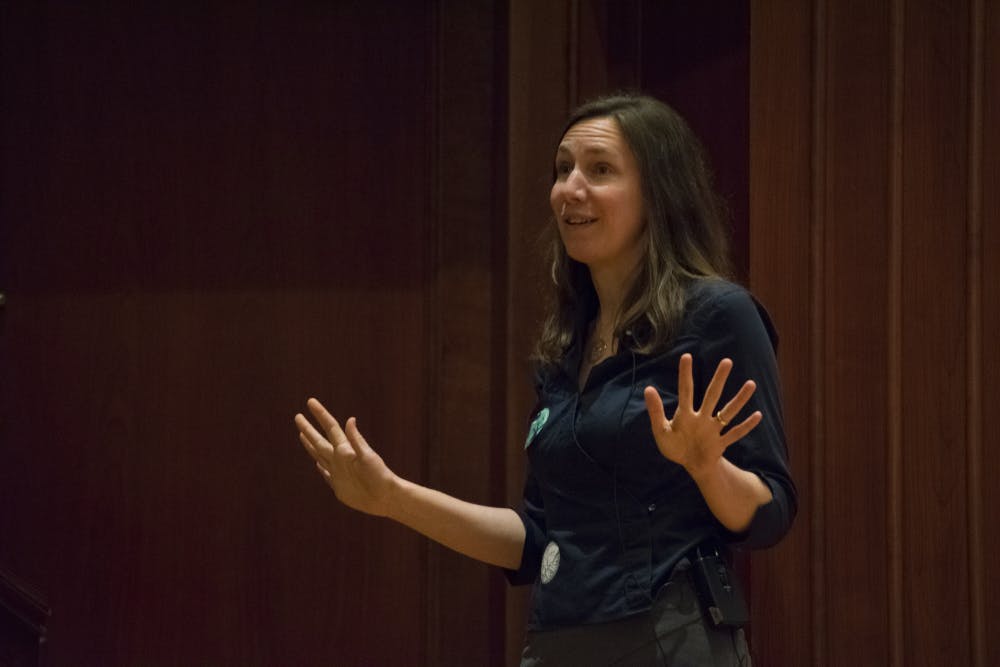By George Tatoris
News Editor
There are around 400,000 plant species on Earth, but only 7,000 of them are edible and cultivable. Among those 7,000, just 90 are commonly cultivated around the world, and out of those 90, three — wheat, rice and corn — make up 50 percent of the average human’s daily calories.
The lack of biodiversity on our plates was the theme of the biology department’s campus-wide Tasting the Tree of Life event held on Feb. 28, which included a revamped Eickhoff Hall menu designed for diversity and a keynote lecturer in Mayo Concert Hall, botanist Nyree Zerega.
Each station in the Atrium was repurposed to reflect a specific theme of biodiversity.
Field guides were positioned at each station, ready to explain the exotic foods being served. The menu included foods like alligator sausage, frog legs, jackfruit sandwiches, breadfruit cakes and roasted crickets. Familiar dishes were being served with a twist, as well — Quimby’s Rotisserie served cumin roasted lamb and a clam and bacon pizza was served at Ceva Pizza.
So, why is biodiversity in food necessary?

“All levels of diversity are important, especially within that food domesticate, whether it be plants or animals,” Zerega said.
More biodiversity within a species can prevent famine because the species would be better equipped to fight new diseases or threats with their genetic reservoir, according to Zerega. A lack of diversity can lead to disasters such as the Irish Potato Famine.
She added that biodiversity can also provide people with more varied nutrients that they otherwise could not get. Certain food varieties can also be adapted to parts of the world experiencing drought or famine.
Zerega explained the three main branches that create the tree of life: eukaryotes, bacteria and archaea. Bacteria and archaea are single-celled organisms, however, archaea tend to live in extreme places such as hot springs and salty environments. Eukaryotes are organisms made up of cells that contain a nucleus and other more complicated structures.
The menu at Eickhoff featured 149 ingredients across all three of these branches. There was even a salt-tasting station where students could taste archaea. A many-branched tree diagram demonstrated the variety of ingredients used throughout the day.

Including all of these branches creates phylogenetic diversity. Zerega showed the audience a photo of a bison near some hot springs to demonstrate the point.
“You got this picture and you think of what’s in there in terms of biodiversity, you see some trees… a bison. It doesn’t look that diverse,” Zerega said. “But, if you think about it in a phylogenetic sense, you got these hot springs, which are home to many different species of bacteria and archaea… and then you got eukaryota.”
Zerega said biodiversity can be found within a branch of the tree of life as well with a slide of a rainforest. Every organism pictured was a tree, but there were many different types.
There can also be biodiversity within the same species, such as with different breeds of dogs. Similarly, the plant Brassica oleracea — possibly a child’s worst nightmare — has been bred over the years to yield cabbage, Brussel sprouts, broccoli and cauliflower.
Kohlrabi, another variant of Brassica oleracea was one of the 149 ingredients in Eickhoff on Tuesday.
Two others are the jackfruit and the breadfruit, two plants Zerega is familiar with — she studied both as a part of her research into underutilized crops.
“An underutilized food crop is a plant species that has some sort of proven food use, it’s been shown to be cultivable at some point, but for some reason, it’s currently less cultivable than it could be,” Zerega said.
These are crops that might be more nutritious or better-suited to locations that can’t grow more-widely known crops, but because of economic, cultural or political reasons, they are not widely cultivated.
The breadfruit is a semi-tropical fruit found in the South Pacific with many positive, underutilized traits, according to Zerega. The fruit is versatile and nutritious and the tree itself can live a long life in places lacking food. Zerega showed two maps, one showing areas where the crop can be grown and another showing places devoid of food, overlapping in certain areas.
The jackfruit, a relative of the breadfruit, can be found in tropical regions and is also underutilized, according to Zerega. Jackfruit is the largest fruit to come from a tree, growing up to 50 pounds.
The massive fruit was on display at the 31 North Deli in Eickhoff, where it was used in a barbecue jackfruit sandwich. Breadfruit cakes were served alongside the sandwiches. At the grill station, a jackfruit Reuben was being served.

Evelyn Kulesza, a sophomore biology major and field guide, said the jackfruit tastes a bit like mango. Ruth Sanchez de la Rosa, a senior biology major and field guide, compared the taste to an apple or pear.
The problem with breadfruit is that most cultivated variants are mostly seedless, and the ones that do have seeds cannot be dried or frozen. This means the crop can only be maintained as a tree. One way to fix these problems is by researching the crop’s relatives on the phylogenetic tree so a better variant can be bred.
Crops aren’t the only foodstuffs being underutilized — we avoid certain animals, too, based on cultural norms and political reasons, namely insects. There are more than 2,000 species of edible insects, mostly beetles and caterpillars, but there is a stigma against using them as food in the West.
“There are so many species (of insect) that are efficient and nutritious, and arguably delicious depending on how you prepare them and what you are used to,” Zerega said.
Compared to cows, pigs and chickens, insects produce the most food in relation to the size of their bodies, meaning there is less waste, according to Zerega. Less feed is also needed to maintain a healthy supply of crickets than other animals.
Crickets and cheese-flavored larvae were served to students in Eickhoff on Tuesday. The crickets had a slightly nutty taste and a crunchy, flaky texture while the larvae tasted kind of like Cheetos.
The Eickhoff overhaul needed eight months of planning between students, faculty and Sodexo staff. Okxana Cordova-Hoyos, a senior biology major, was a part of the Scientific Planning Committee that helped plan the event. She said the main point of the event was to spread an understanding of science through something everyone enjoyed — food.
“We figured everyone loves food so we combined the two (food and science),” Cordova-Hoyos said.
She said the event was designed to make students think of their food in a different way.
“It’s a different way of thinking about balancing a meal,” she said.
Wendy Clement, an assistant professor in the biology department and committee chair, went into detail about that different way of thinking.
She hopes that students “recognize that every ingredient on their plate is a living organism that has a story of its own and that what they eat represents many different lineages of the tree of life.”
Kathryn Elliott, as assistant professor of biology and member of the committee, hoped students learned something about the richness of life on Earth.
“We really wanted to convey that all organisms on life are related in one big family tree, the Tree of Life, that there is an incredible amount of biodiversity on Earth, which we tried to illustrate by showing how diverse your foods can be, and that humans have an impact on that biodiversity,” Elliott said.
After the committee approached Sodexo with a list of ingredients, Executive Chef of Resident Dining Lauren Franchetti went to work designing a menu.
“We have over 300 different foods on inventory in the Eickhoff kitchen, it is not often that we get to work with an ingredient that is completely new to the kitchen team,” Franchetti said. “It was a great experience to break from the norm and have some fun tasting and working with something completely new to us.”
The professors and Franchetti came out of the eight-month experience with new knowledge and a palette for exotic foods.
Elliott enjoyed the jackfruit cake and Franchetti liked the frog legs. Clement enjoyed the jackfruit Reuben, but what she liked the most was something familiar that reminded her of home.
“I’m a New Englander at heart, so I did also enjoy the clam and bacon pizza,” Clement said.







